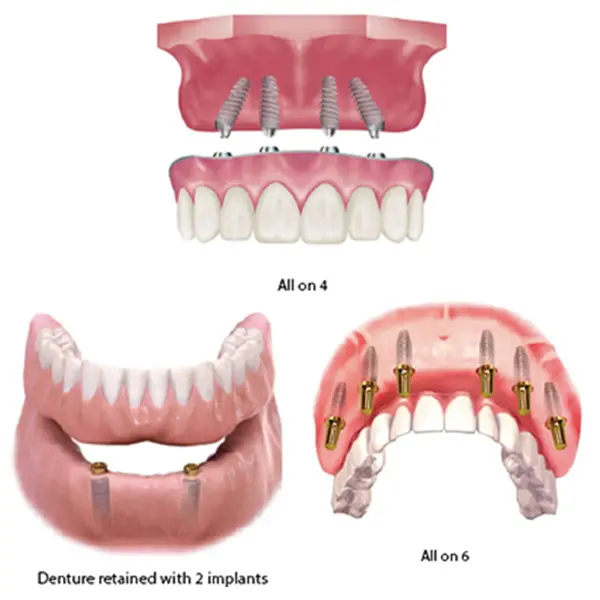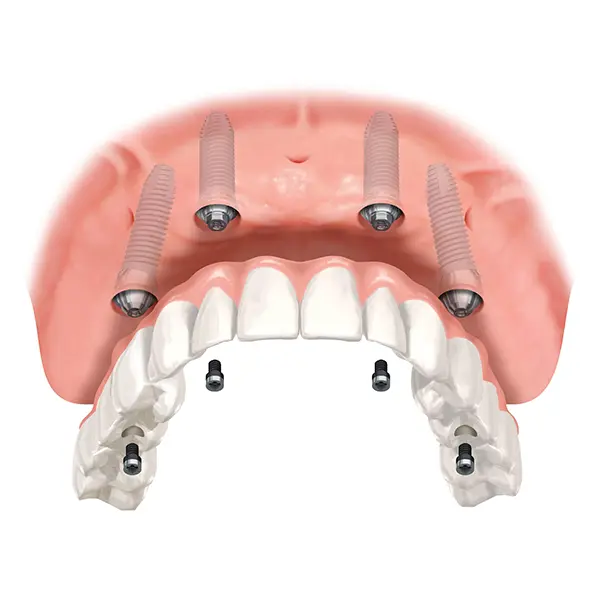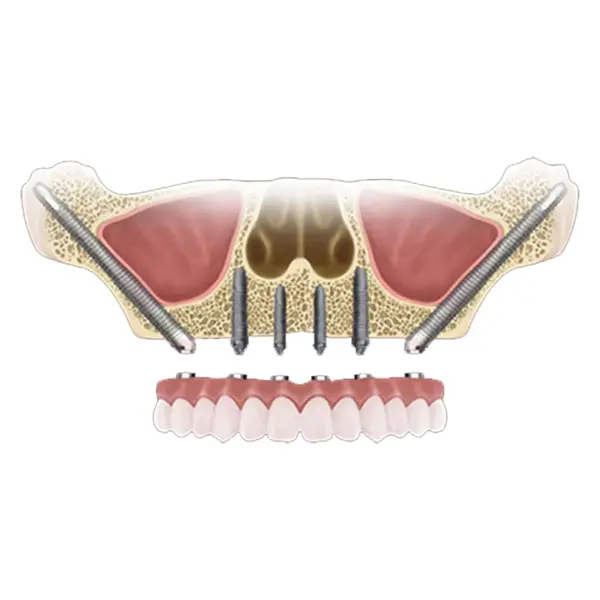What is full mouth rehabilitation or restoration?
Full Mouth Rehabilitation is conducted when the majority of the teeth in a patient's mouth need restoration and correction. In this procedure, the entire mouth of the patient is taken care of, while also keeping major focus on the aesthetic front.
In other words, full-mouth restoration combines aesthetics with the functionality of teeth and gums, with a set of dental procedures tailored to the patient's specific needs. When reconstructing & restoring oral health, treatment options for jaw joints, bite, smile, and facial support are all taken into account.
Full-mouth rehabilitation can replace missing teeth, repair teeth alignment, fill in gaps, treat periodontal disease, improve any TMD symptoms, improve your smile, boost confidence, and more importantly improve your overall health.
Full Mouth Rehabilitation – Evaluation & Treatment Planning
Patients with multiple dental issues are typically the ideal candidates for a full mouth restoration or rehabilitation.
- Comprehensive Examination : The first step is thoroughly evaluating your oral health. This includes a detailed examination of your teeth, gums, bite, jaw joints (TMJ), and any existing restorations. X-rays, impressions, and other diagnostic tests may also be taken to assess the condition of your teeth and supporting structures.
- Dental Records and History : Your dental records, including any specific concerns or symptoms you may have, will be reviewed. This information helps identify underlying issues and understand your overall oral health status.
- Digital Imaging and Models : Advanced digital imaging techniques, such as 3D or intraoral scans, may be utilized to obtain detailed images and models of your teeth and jaws. These help in visualizing the current condition and aid in the planning process.
- Occlusal Analysis : An analysis of your bite and occlusion (how your teeth come together) is conducted to identify any misalignments, imbalances, or problems with the jaw joint. This information is essential for achieving proper functional and aesthetic outcomes.
- Treatment Options and Goals : We will discuss the treatment options suitable for your needs based on the evaluation, considering factors like tooth restoration, replacement of missing teeth, bite correction, gum health, and aesthetics. Together, we will establish treatment goals and prioritize the necessary procedures.
- Collaborative Approach : Full Mouth Rehabilitation often requires a collaborative effort between dental specialists, such as prosthodontists, periodontists, orthodontists, and oral surgeons. At Symmetry we have an in house team of specialists to create a comprehensive treatment plan.
- Treatment Timeline & Financial Considerations : The doctors will provide a proposed treatment timeline outlining the sequence of procedures and estimated duration. They will also discuss the associated costs and any available financing or insurance options.
Who is an ideal candidate for full mouth rehabilitation?
Here are some reasons why an individual may require Full Mouth Rehabilitation :
- Extensive tooth loss : Full Mouth Rehabilitation can offer a method to replace the missing teeth and regain oral health when a person has lost numerous teeth, whether due to disease, trauma, or other causes.
- Worn or damaged teeth : Full mouth rehabilitation may be necessary to replace and strengthen teeth that are badly broken, worn down, or damaged, improving both function and beauty.
- Misalignment : Full Mouth Rehabilitation can assist in correcting the bite and restoring a balanced and functioning occlusion if there are problems with the jaw’s placement or the bite.
- Temporomandibular joint (TMJ) issues : Full mouth rehabilitation can treat TMJ disorders with symptoms like jaw pain, headaches, and difficulties opening and closing the mouth.
- Cosmetic issues : Full mouth rehabilitation may be the best option for those with several aesthetic problems, such as stained teeth or teeth that are malformed or spaced unevenly.
Most Common Procedures Conducted Under Full-Mouth Rehabilitation
Dental Implants
Full Mouth Implant Rehabilitation is a comprehensive treatment approach involving the replacement of all missing teeth with dental implants. It focuses on the complete restoration of the entire mouth, typically in cases where a patient has lost many teeth or has extensive dental issues.
Types of full mouth implant rehabs :
- All on 6
- All on 4
- All on X
- Zygomatic/Pterygoid Implants for Atrophic Maxilla
- Implant Supported Overdentures

Inlays & Onlays to cover cavities
Inlays and Onlays are used when a tooth has experienced too much damage and cannot support a basic filling, but the damage is not extremely extensive that a crown is necessary.
An inlay is a dental restoration that fills cavities in the regions between the cusps of a tooth.
An Onlay can work for a larger area, including the cusps. Their function is similar to crowns, although they do not cover the entire tooth surface as a crown does.
These are more expensive than a traditional filling, but they last longer.
Dental Crowns to restore, or protect teeth
Dental crowns are caps that are placed on top of broken or decayed teeth. When fillings fail to solve the problem, crowns are utilized to preserve, cover, and restore the shape of your teeth.
Dental Veneers to improve the aesthetic appearance
Dental veneers may be an option for you to attain the look you want. They're a common solution for people who have chipped teeth, a gap between their teeth, or teeth that are misshapen.
They are thin covers that are glued to the front of teeth to give them a more aesthetically formed appearance.
Treatment of TMJ (Temporomandibular Joint)
Diagnosing the strain in TMJ or muscular tension due to overgrinding of teeth caused by stress or out of unintentional habit, can be treated with occlusal splints/guards.
Conducting Arthrocentesis which is a minimally invasive procedure or arthroscopic surgery – This is known to be effective for treating various types of TMJ disorders or open-joint surgery (arthrotomy) to repair or replace the joint.
Recent Advances in Full Mouth Rehabilitation
Recent advances in full mouth dental rehabilitation have revolutionized dentistry, offering patients enhanced treatment options and improved outcomes. Some notable advancements include :
- Digital Dentistry : Integrating digital technologies, such as intraoral scanners, 3D imaging, and computer-aided design/computer-aided manufacturing (CAD/CAM), has transformed the treatment planning and fabrication of restorations. Digital workflows provide greater accuracy, efficiency, and customization, resulting in more precise and natural-looking restorations.
- Guided Implant Placement : Computer-guided implant placement allows for precise positioning of dental implants, leading to improved stability and aesthetics. By combining digital imaging and virtual planning software, dentists can accurately determine implant size, angulation, and placement, resulting in predictable outcomes and reduced treatment time.
- Minimally Invasive Techniques : New approaches focus on preserving tooth structure, such as conservative cavity preparations and adhesive dentistry, reducing the need for extensive dental work and promoting long-term oral health.
- Biomaterials and Prosthetics : Advances in dental materials, such as zirconia and high-strength ceramics, provide durable and aesthetically pleasing options for crowns, bridges, and veneers. Additionally, flexible and bio-compatible denture materials enhance comfort and fit.
- Digital Smile Design : Digital Smile Design (DSD) is a powerful tool that combines technology and artistry to design customized smiles for patients. By utilizing digital imaging and mock-ups, dentists can visualize and communicate potential treatment outcomes with patients, enabling them to actively participate in the design process and achieve their desired aesthetic goals.
Additionally, a very important point to note in full mouth rehabilitation is that – the vertical dimension (the distance between two chosen points on the face above and below the mouth when the teeth are in occlusion) will need to be increased to avoid TMJ issues. Changes in vertical dimension can allow for more conservative dental rehabilitations.
A full mouth reconstruction can help protect your oral health by effectively treating a variety of disorders such as tooth decay, gum disease, tooth loss, and severely damaged teeth, all at once.


